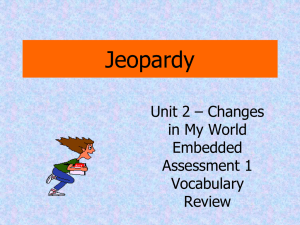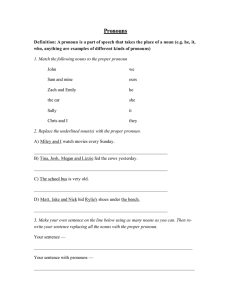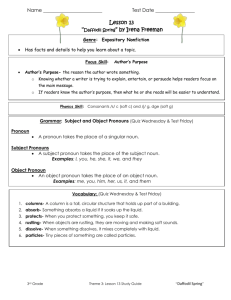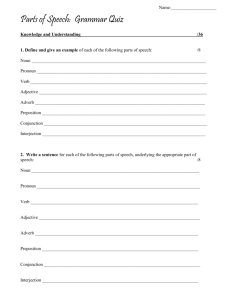XVI. MECHANICAL TRANSLATION V. H. Yngve M. Grosst
advertisement
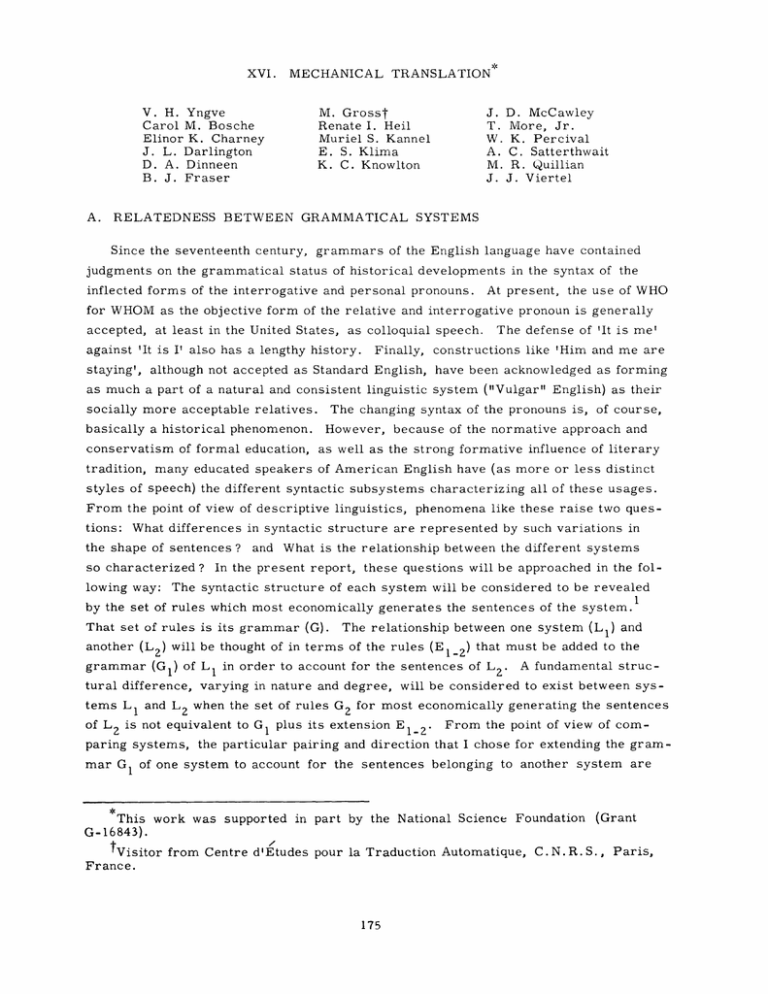
XVI.
MECHANICAL TRANSLATION
V. H. Yngve
Carol M. Bosche
Elinor K. Charney
J. L. Darlington
D. A. Dinneen
B. J. Fraser
A.
M. Grosst
Renate I. Heil
Muriel S. Kannel
E. S. Klima
K. C. Knowlton
RELATEDNESS BETWEEN GRAMMATICAL
J.
T.
W.
A.
M.
J.
D. McCawley
More, Jr.
K. Percival
C. Satterthwait
R. Quillian
J. Viertel
SYSTEMS
Since the seventeenth century, grammars of the English language have contained
judgments on the grammatical status of historical developments in the syntax of the
inflected forms of the interrogative and personal pronouns.
At present, the use of WHO
for WHOM as the objective form of the relative and interrogative pronoun is generally
accepted, at least in the United States, as colloquial speech.
against 'It is I' also has a lengthy history.
staying',
The defense of 'It is me'
Finally, constructions like 'Him and me are
although not accepted as Standard English, have been acknowledged as forming
as much a part of a natural and consistent linguistic system ("Vulgar" English) as their
socially more acceptable relatives.
basically a historical phenomenon.
The changing syntax of the pronouns is,
of course,
However, because of the normative approach and
conservatism of formal education, as well as the strong formative influence of literary
tradition, many educated speakers of American English have (as more or less distinct
styles of speech) the different syntactic subsystems characterizing all of these usages.
From the point of view of descriptive linguistics,
tions:
phenomena like these raise two ques-
What differences in syntactic structure are represented by such variations in
the shape of sentences ?
so characterized ?
lowing way:
and What is the relationship between the different systems
In the present report, these questions will be approached in the fol-
The syntactic structure of each system will be considered to be revealed
by the set of rules which most economically generates the sentences of the system.1
That set of rules is its grammar (G).
another (L
2
The relationship between one system (Ll) and
) will be thought of in terms of the rules (E
1 _2
) that must be added to the
grammar (Gl) of L 1 in order to account for the sentences of L 2 .
tural difference,
tems L
1
A fundamental struc-
varying in nature and degree, will be considered to exist between sys-
and L 2 when the set of rules G 2 for most economically generating the sentences
of L 2 is not equivalent to G 1 plus its extension El_2.
From the point of view of com-
paring systems, the particular pairing and direction that I chose for extending the grammar G 1 of one system to account for the sentences belonging to another system are
*This work was supported in part by the National Science
Foundation
G-16843).
+
(Grant
/
'Visitor from Centre d'Etudes pour la Traduction Automatique, C.N.R.S.,
France.
175
Paris,
Table XVI-1.
L
a
Representative sentences of the four related systems.
1
L2
3
L4
1) She could see him near me.
2) He and I left.
Him and me left.
3)
Us two left.
We two left.
4) We all left.
5) It was I.
6) Could she see him?
7) Who could see him?
8) Whom could she see?
3
L
9) With whom did he speak?
10) Whom did he speak with?
11)
It was me.
Who could she see?
Who did he speak with?
Who was it?
12) Who was the leader?
13)
14)
He knew whether she could see him.
He knew who it was.
15)
He knew who was the leader.
16) He knew whom he spoke with.
He knew who he spoke with.
17) The leader who could see him left.
18) The leader whom I saw left.
19) The leader with whom he spoke left.
The leader who I saw left.
20) The leader whom he spoke with left.
The leader who he spoke with left.
(XVI.
MECHANICAL
TRANSLATION)
However, except when so noted, the order in which the styles
admittedly arbitrary.
are considered recapitulates comparable aspects in the historical development of the
pronouns.
Of course, my presentation deviates in an essential way from true historical
perspective:
The sequence of pronominal systems abstracted from consecutive stages
of the language is collapsed,
as it were, and each system treated as part of an otherwise
identical total system.
Table XVI-1 contains sentences that are representative of the four systems to be
related.
A blank space under any L signifies that the sentence is the same in its final
shape as that one on its immediate left.
It is assumed that, aside from the differences
in final shape presented by the sentences in Table XVI-1 and by the other sentences of
the systems like them, the rest of the sentences have the same shape.
Consider,
first, only L 1 , which is typical of a style that might be referred to as
"elegant literary."
Classifying representative sentences in the particular four types
given in Table XVI-1 (a, P, y, 8) follows traditional grammatical usage:
atives; p, interrogative structures corresponding to the latter; y,
a, simple declar-
structures corres-
ponding to interrogatives but contained as constituents of complex declaratives (and
related structures) in the form of indirect questions; 6,
sentences themselves containing
structures, relative clauses, which are closely related to independent sentences.
The
notions - common to intuitively based traditional classification - of "correspondence"
and "relatedness" between types of structures would not be without analogues in the
rigorous formal description of the language.
impression of "correspondence"
It will be found that accompanying such
and "relatedness" are formal facts like the recurrence
of certain basic grammatical features between representatives of different structural
types.
For example, the same sorts of subjects and objects (to use traditional terms
for major functional units in the syntactic system) occur with the same verbs.
Also,
although the phenomenon may be of lower order with respect to basic grammatical features, the same agreement holds between subjects and verbs, regardless of the type of
structure.
But, although the functions of the major elements remain the same, the final
shapes of sentences differ according to the type of structure.
of the elements differs.
In
In particular, the order
a the subject is before the finite verb; the finite verb forms
the head of a chain of verb forms, interrupted only by certain adverbs,
occurs after that verb chain.
more complicated.
and the object
With respect to the order of such elements, group
P
is
Often the particular word order of one sentence as compared with
that of another can be attributed to clear grammatical differences elsewhere in the sentence (e. g;, inversion in
to the word order in
where as in p).
p
when accompanied by an interrogative word, as contrasted
a; direct order in a subordinate clause as in y, but inversion else-
The basic order of elements will be that (or those) from which the ulti-
mate particular word orders, as well as other grammatical features, are most simply
specified.
Often, while major functional elements like subject and object cannot be
177
(XVI.
MECHANICAL TRANSLATION)
specified in a simple way on the basis of their position in the total set of sentences
representing all possible structural types, their position in terms of the basic order
of elements is significant for their specification. Clearly, in English the relationship between the order of elements and their grammatical function is simpler in a
than in p; and y and 6 are more complicated since they contain instances of a and
p. For convenience, in fact, we can refer to the word order of a, with only a few
modifications,
as basic.
The position of an element is
thus relative to the level of syntactic structure.
Among grammatical
features describable by position at the level characterized by
the presence of basic word order is the occurrence of the objective form of pronouns
in L1
.
The occurrence
of HIM rather than HE,
various structures of L
1
and WHOM rather than WHO in the
exemplified in Table XVI-1 follows from a principle of
syntactic function that may be stated in terms of position in the simple declarative
sentence; i.e., that pronouns following transitive verbs and prepositions occur in
their objective form.
Thus, 1) in L 1 is the ultimate form of a sentence like She could - see - he + CASE - near - I + CASE.
The specification of function at the
level of the simple sentence in terms of the occurrence of inflectional forms corresponds to the traditional notion, whereby HIM and WHOM are the forms taken
by the pronouns as "objects" of verbs and prepositions, and whereby WHOM in
8)-10),
16),
19),
or preposition,
etc.
is
still considered to be the "object"
even though the
"object"
is
separated
from
of a transitive verb
its governor
and may
even precede it.
Consider, first, the direct questions
P.
The direct question can be thought of essen-
tially as a single sentence,
sentence (e.g.,
specified by an interrogative marker (Wh) introducing the
6) in L 1 would have the form Wh - she - could - see - he + CASE). The
interrogative specifier Wh-
can remain unattached or can have attached (indicated by +)
to it various elements of the sentence, including instances of the pronoun marked with
CASE; e.g.,
8) in L1:
Wh + he + CASE - she - could - see, and 7) in L 1 : Wh + she could - see - he + CASE. The special word order of direct questions can be explained
as the attraction of the finite verb form to Wh and its attachments; i. e., Wh - she could - see - he + CASE i
Wh - could - she - see - he + CASE; Wh + he + CASE she - could - see =4 Wh + he + CASE - could - she - see; Wh + she - could - see - he +
CASE already has the finite verb beside it.
In direct questions, unattached Wh- is not
represented phonologically. In indirect questions, which constitute questions embedded
as subordinate clauses in other sentences,
out
unattached Wh- appears as WHETHER.
further justification,
With-
I symbolize subordination by THAT, which blocks the
Wh-attraction resulting in the inverted word order of questions; i. e., Wh + he + CASE she - could - see ultimately yields 'Whom could she see ?' but under subordination,
we have
178
(XVI.
MECHANICAL TRANSLATION)
THAT - she - could - see -
that - she - could - see him
he + CASE
Wh + she + THAT - could see - he + CASE
21)
he - knew
Wh + he + CASE + THAT she - could - see
who - could - see - him
he - knew
Wh + THAT - she - could see - he + CASE
whom - she - could - see
whether - she - could see - him
The relative clause also represents embedding with subordination, with the condition
that the two sentences involved have an identical constituent.
Sentence 16) in L 1 repre-
sents the subordination of 'I saw the leader' to the identical noun in 'The leader left'.
It is simplest to consider the subordinated sentence after pronominalization;
saw - he.
i.e., I -
After case-marking, the latter has the form: I - saw - he + CASE, which,
when attached to Wh and embedded,
left' yields:
with subordination,
into the Nominal of 'The leader
The - leader - Wh + he + CASE + THAT - I - saw - left.
Marked case is
again determined in terms of position with respect to basic word order.
Conjoined
forms like 2) can be thought of as the replacement of a plural subject by any number
of other compatible subjects:
Given he - left and I - left, we can embed the subjects
in They - both - left to yield:
He - and - I - both - left.
The marked or unmarked qual-
ity of the pronouns is carried over into conjunction in
L 1.
In the grammar comprising the rules for generating the sentence of L1,
the rules
of the phrase-structure level, abbreviated to the special demands of the present report,
would have the following general appearance2
( {vbe
22)
23a)
S -
(Wh) Nominal - Tense (V m )
Verb - Nominal -
(
V
r
V
- prep
be Predicative
Verb}
V
Verb (Nominal)
} Nominal
23b)
Verb - Predicative - V c - Predicative
23c)
Verb - V I
4)
Vt
know
see
25)
V
- be
26)
Vc - become
27)
VP -
speak
179
(XVI.
MECHANICAL TRANSLATION)
-leave
28)
V
29)
speak - prep - speak - with
30)
Vm - can
31)
tense
Past
PrePast
Present
Pronoun
John
the leader
32) Nominal -
33)
Number -
34)
Pronoun-
Number
Sg
P1
I
he
she
Other obligatory rules, of transformational nature, carry into sentences the strings
emerging from the phrase-structural level, along with operations accumulated in the
3
transformational level.
35)
Tense attachment:
36)
DO - proclysis:
Tense - V z:
- Tense -=
37a) Wh + Pronoun - Number =
do + Tense
who
37b)
Wh + Pronoun + CASE - Number
38a)
I + CASE - Sg
38b)
do + Past j
did;
be + Past
was;
-
, me;
V + Tense
4
whom
he + CASE - Sg
can + Past z
could;
leave + Past
left;
him
speak + Past => spoke;
see + Past
> saw
The transformational rules, in their appropriate order, which account for the grammatical features associated with case would be:
39)
I.
Case-marking:
Pronoun
prep
II.
Conjoining:
Vp
prep
Pronoun + CASE
S': X' - Pronoun + CASE - P1 - Y'
S11: X" - Nominal" - Y"
S"': X"' - Nominal"' - Y"'
::
X' - Nominal" - and - Nominal"' - P1 - Y'
180
(XVI.
III.
Wh-attachment,
Wh +
IV.
V.
including subordination where appropriate 4
Prep - Pronoun + CASE
Pronoun (+ CASE)
Wh-. .
MECHANICAL TRANSLATION)
Prep - Pronoun + CASE
Pronoun (+ CASE)
Number
Number (+ THAT) ...
Preposition placement 5 : Wh + Prep - Pronoun 4
Prep - Wh + Pronoun
Wh-attraction:
z
Wh (+ Pronoun + CASE - Number) - Nominal - Tense (Vm) Verb
Wh (+ Pronoun + CASE - Number) - Tense (Vm) Nominal - Verb
Consider now L 2 , one variety of Colloquial English. To account for the sentences
of L 2
proceeding from the grammar of L 1 , a rule (E 1 _2) must be added which reduces clause
initial WHOM to WHO.
The case form, however, is retained when WHOM is preceded by
a preposition, cf. 9) versus 10) and 18) versus 19) in L 2 . The extension E1after Wh-attachment,
WHOM ...
.
but before preposition placement,
and thus
leave
2
...
would occur
WITH
Thus G 1 + E 1 _ 2 , the Gl-based grammar of L 2 , would have the following
difference in appearance.
40)
G1 + E1_2
III.
E 1-2
IV.
Wh-attachment
4 Wh + Pronoun - Number
Wh + Pronoun + CASE - Number
Preposition placement
The extended set of rules with G 1 as a basis accounts for the sentences of L
the point of view of L 2 independently, however,
From
the sentences are most economically
described by a grammar (G 2 ) that differs from that of L
tional rules.
2.
1
in the order of the transforma-
In G 2 , the rule of case-marking is dependent on the position of the ele-
ments of the sentence as they occur after Wh-attachment.
The difference in order of
rules reflects the fact that while in L 1 case-marking is dependent on function (namely
whether or not the element is a grammatical object),
in L 2 CASE, or more properly
lack of CASE, is a concomitant of position as reckoned after certain major distortions
of the basic order of elements. Thus in L 2 , CASE is not associated with functional elements if they do not occupy a position after the motivating factors.
Other things being
equal, the grammar G 2 would consist of the same phrase-structure rules as G 1 , but
the order of the transformational rules would be different.
181
(XVI.
41)
MECHANICAL TRANSLATION)
G2:
...
I.
Wh-attachment
II.
Case-marking
III.
Conjoining
IV.
Preposition placement
V.
Wh-attraction
L3 differs from L 2 in containing a further extension of the positional determination
of CASE to cover also pronouns representing the Predicative; i.e., those following Vbe
and V c
.
Position in this case is reckoned, as elsewhere in G 2 , after Wh-attachment.
Thus 5) is marked in L 4 but 11) and 14) are not.
Extension E2-
3
would have the fol-
lowing effect:
{V
Pronoun - Number
Vcbe
Pronoun + CASE - Number,
or that which amounts to the same thing,
V [Pronoun - Number]Predicative
42)
G 2 + E2-3:
4
V [Pronoun + CASE - Number]Predicative
...
I.
Wh-attachment
II.
Case-marking:
Vbe
prep
et p
rb
E 2 .3 .
III.
V
re
Pronoun - Number
4
Pronoun + CASE - Number
Pronoun - Number
V - Pronoun + CASE - Number
Conjoining
In G 3 the difference attributable to E2-3 is represented by the extension of casemarking to all pronouns following a verbal form V, so that CASE becomes entirely a
positional feature without functional reference.
The phrase structure of G 3 remains
the same, as does the ordering of transformational rules.
From the point of view of
units represented in the phrase structure, case-marking is generalized in G 3 , in that
it applies to a unit of a higher level of the phrase structure:
as extended by E2-
3 , Vc
182
Verb rather than Vt and,
MECHANICAL TRANSLATION)
(XVI.
43) G 3
II.
Case-marking:
4
Ver
Pronoun - Number
Verb
Pronoun + CASE - Number
In terms of the class of units V, the generalization can be expressed simply as:
44)
G3:
...
II.
Case-marking:
V - Pronoun - Number
=
V - Pronoun + CASE - Number
It should be noted that the ordering of Wh-attraction after case-marking accounts for the
fact that in the final form taken by sentences, the unmarked form can also occur regularly following a V; e.g.,
'Who is he ?'.
'Has he left ?',
When case-marking applies to
these sentences, however, they have the form Wh -he -has -left and Wh+ Pronoun -he -is.
From the point of view of G 3 , the sentences in L 4 manifest a further extension
of case-marking to all pronominal forms before Tense, except for interrogative-relative
WHO and unconjoined pronouns directly adjacent to Tense:
45) E 3
4:
X - Pronoun + CASE - Number - Y
X - Pronoun - Number -Y
provided that X * Wh+ and Y
Grammar G 4 differs from G 3 + E3-
4
#
Tense
with respect to its rules in both the transforma-
tional and the phrase-structure levels. The basic forms of the personal pronouns
emerging from phrase structure are those previously resulting from combination with
the case markers. The order of the transformational rules is different; case-marking
now occurs even later in the grammar than conjoining and is limited in application, in
the case of the personal pronouns, to a position that is immediately before the finite
verb. The ultimate positional nature of case-marking in L 4 thus does not even observe
the weakly functional principle of similarity involved in conjoining. If sentences like
9) and 19) are admitted in L4, then the marking of the relative-interrogative form
remains essentially the same as in G 3 . Thus, while the marked forms of the personal
pronouns yield I, HE, THEY, etc.,
that of the interrogative-relative would yield WHOM.
It would probably lead to greater homogeneity not to consider the sequence of a preposition followed by WHOM in '...
of L 4 .
with whom he spoke ...
',
as in 9) and 19),
Then in G 4 , Wh-attachment would analyze the string:
183
as part
Wh - he - spoke - with -
(XVI.
MECHANICAL TRANSLATION)
Pronoun only as:
Wh - ...
Pronoun ...
and not also as Wh - ...
as was the case in the other grammars.
according to whom we were at fault,
Prep - Pronoun ...
Consider now constructions like
would not condone such action',
,
'John,
as well as related
ones,
not discussed here, like 'The concert during which he slept was a great success',
i.e.,
constructions of L 1 , etc.,
which do not permit the separation of the preposition
from its object in relative clauses.
If this style of construction, too, is not considered
to be a part of L 4 , then Wh-attachment is simplified and preposition placement is omitted from the grammar, as are operations involved in realizing the form WHOM.
that are unnecessary when L 4 is considered in this way are bracketed
Rules
[ . In L 4 as in
the other systems, case-marking applies before the inverted-order characteristic of
direct questions.
etc.
This accounts for the presence,
after the finite verb.
in certain sentences,
of I, HE,
THEY,
Apparent exceptions to the rule of case-marking in G 4 such
as 4) in L 4 or 'They each left' versus 'Us two left' are best explained on the basis of
the special structural position of words like EACH and ALL in these sentences:
namely,
that, although grammatically restricted by the nature of the nominal, these forms are
constituents rather within the predicate of the sentence, as is clear when the predicate
is in expanded form; e.g.,
'They have all left'.
The structure of G 4 would have the
following difference:
46)
G4 :
33)
...
34)
Pronoun -
35)
...
36a)
36b)
37a)
me
him
her
same as in
G1,
etc.
Wh + Pronoun - Number
4
who
[Wh + Pronoun + CASE - Number
me + CASE - Sg
=
I;
him + CASE - Sg
4
whom]
he
The transformations accounting for the introduction of CASE in 36b) and the ultimate
word order of the sentences would now have the following form and order:
47)
I.
II.
III.
Wh-attachment
Conjoining
[Preposition placement with case-marking:
Number
IV.
,
Case-marking:
Wh + preposition - Pronoun -
preposition - Wh + Pronoun + CASE - Number]
- Pronoun - Number - Tense
=i
- Pronoun + CASE - Number - Tense
(the sequence "- Pronoun . .. " differentiated from "+ Pronoun ...
184
")
Table XVI-2.
L
1
Summary of differences in ordering of main transformations
L2
Pronoun -
L
L4
3
Pronoun -
I, he, she
me, him, her
Wh-attachment
Case-marking
Wh-attachment
Conjoining
Case-marking
Wh-attachment
Conjoining
[Preposition placement,
with concomitant CASE]
Preposition placement
Preposition placement
Case-marking
Wh-attraction
Wh-attraction
Wh-attraction
Case-marking expanded
Conjoining
(XVI.
V.
MECHANICAL TRANSLATION)
Wh-attraction
It should be noted that in the structure resulting from conjoining, the constituent 'Pl',
which represents the number of the constituent replaced by the conjoined nominals,
leaves a string to which 47) IV does not apply.
In the derivation of 2) in L 4 , for example,
at the level of case-marking in G 4 the string has the following shape:
him - Sg - and -
me - Sg - P1 - Tense - leave.
We have examined in sequence four systems.
A given system and that following it
in the sequence were compared to see how the differences between them, in terms of
the sentences each contains, are reflected in their individual grammars.
An operation
common to the four systems - the attachment, motivated by position, of a marker (case)
to a certain class of words (pronouns) - is found to manifest a progressively weaker
relationship to function, as illustrated in Table XVI-2.
E.
S. Klima
References
1. This notion of grammar is developed by N. Chomsky, Syntactic Structures
(Mouton and Company, s'Gravenhage, 1957). A detailed treatment of specific grammatical problems can be found in R. Lees, A grammar of English nominalizations,
Int. J. Am. Ling. 26, 3 (1960).
2.
The use of the unnecessary symbol V b e , rather than simply BE,
convention for abbreviating the class of elements formed by Vc, V t , V I
the otherwise nonoccurring symbol without superscript V.
is part of a
,
and Vx with
3. Similar rules would attach P1 as 's' to an immediately preceding noun and ultimately remove all other number markers. Thus the dangling 'P1' (plural) resulting
from conjoining in 34) is removed with the same operation that removes the empty 'Sg'
(singular) after nouns in English, and to this extent is no more arbitrary.
4. For a more precise analysis, I would propose deriving questions, but not relative
clauses, from sentences in which the Pronoun that is to be attached to Wh is one of the
indefinites: SOMEONE, ANYONE, or SOMEBODY. In this way, certain characteristics
of questions (direct and indirect), but not of relative clauses, would be accounted for;
e.g., 'Who else left ?' is like 'Someone else left'; 'Whom did he see of importance ?'
is like 'He saw someone of importance'. If we consider CASE to be applicable also to
the indefinites, then the rest of the analysis need not be changed essentially.
5. The operation, designated here as preposition placement, which is necessitated
by the sequence Wh - prep - pronoun ... left by Wh-attachment is not an indication of the
arbitrariness of Wh-attachment, for the latter serves also to prevent the reduction in
relative clauses of '.. . with whom ... ' to '.. . with that ... ' on a par with the permissible reduction of '... whom ... ' to '... that .. .'; e.g., 'The man whom I spoke with',
'The man that I spoke with' but 'The man with whom I spoke', and not 'The man with
that I spoke'.
Thus between 39) III and 39) IV there is a rule that is applicable only to
relative clauses: Wh + Pronoun + CASE - Number - THAT ! THAT. Further, the
subordinator THAT may itself be deleted except in certain specifiable contexts, and in
others must be deleted: 'He knows that they left' 'He knows they left', 'The man that
I spoke with left' 'The man I spoke with left'.
186


